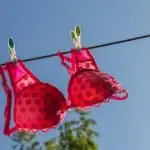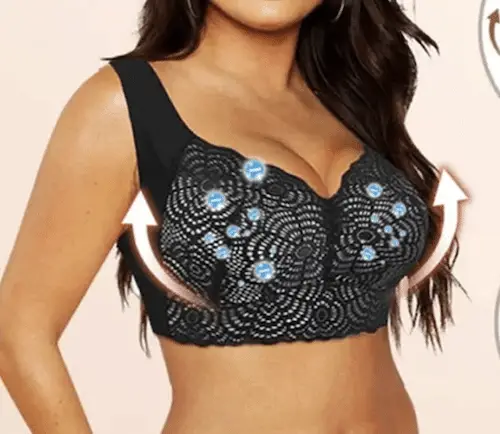Table of Contents
The answer is simple: stop wearing bras.
There’s a lot more to this issue than meets the eye. Sure, sitting all day in an uncomfortable bra can cause skin breakdown around the straps or underwires.
But there might be other factors involved as well: irritating chemicals (scented laundry detergent/ fabric softener/ deodorant etc.), an improper technique for putting on a bra, not washing your bras regularly enough or at all, overusing the bra-fastening tabs (especially if you have a sports/running bra, which are slightly different from regular bras in that they’re typically designed to be worn without an outer layer of clothing, thus resulting in more pressure on your body).
Where does bra rash come from?
Although there are many factors involved in this equation, I’ve narrowed down my favorite culprits:
1. The bra. Of course, it all starts with the actual garment, and never forget that a poor fit is one of the main sources of discomfort.
There’s such a variety of styles and brands available these days that it’s tempting to follow trends or keep up with fashion instead of paying attention to what really makes your own body feel good.
But it’s not only about what bra you wear, but how long you keep wearing it after it’s been rendered useless. Some of my best-fitting bras have become painful to wear simply because I didn’t take good care of them (see “what is the shelf life of a bra?”)
2. The body: Being overweight or obese can cause skin irritation in and around the breasts and all along the upper back due to constant pressure from your own weight pushing down on your breasts.
This is especially true if you don’t exercise regularly, which in many cases may be accompanied by other habits that affect your skin as well (such as smoking).
Also, excessive sweating caused by hot weather or improper diet/ nutrition can lead to rashes in areas you wouldn’t expect.
What kind of rash is it?
Now, there are two kinds: type #1 and type #2. To find out what kind you have simply pinched a bit of your skin on the outside of your breasts in different places and see if the following applies:
If your pinch mark becomes pink and stays that way for several hours after unhooking your bra, this points to skin breakdown caused by constant rubbing against the fabric of outer clothing as well as underwire edges.
This can be prevented if you take proper care of your bras (see “how do I properly wash my bras?”, which includes air-drying them) and wear smooth materials like cotton next to your skin instead of synthetics.
If your pinch mark becomes a straight, red line that doesn’t go away even after you’ve taken off your bra and there are no visible signs of broken skin on the surface (other than redness), this is often caused by a sensitive reaction to certain materials like nickel or chemicals in fabrics.
This kind of rash isn’t always as noticeable and tends to only appear when wearing bras made with certain kinds of material such as synthetic lace. It’s more common in women who wear underwired bras because they’re more likely to be made from these types of materials/chemicals;
I actually experienced this problem myself until I switched my bra wardrobe over to all cotton-made garments last year.
The upside: Braless Bliss
Thankfully, there’s a way to avoid these problems altogether, and that’s by going braless whenever possible.
I realize this is easier said than done, but once you get the hang of it you’ll be glad you took the time to learn how to “free your breasts.” The only trick is getting used to not having any underwire or padding between your breasts, which can feel very strange at first (but also kind of wonderful).
I don’t recommend you do this for the first time on a regular basis while wearing a dress/shirt without anything underneath because everyone will know something is missing!
Also, when setting out for a new bra-free day try some yoga pants that fit snugly around your waist and thighs until you find the right areas to hold your breasts in place.
This will prevent you from feeling exposed when you start walking around without a bra (but don’t forget to move them around occasionally or your chest may feel sore later on).
Why is my bra giving me a rash?
There are many reasons why a bra could be giving you an itchy rash. If yours is only on the outside of your chest and isn’t related to wearing underwired bras, then consider the following:
The fabric of your outer clothing or bra straps is abrasive against your skin. This can often cause a friction rash if you don’t take proper care of your bras (see “how to wash your bra properly”) or wear them for too long.
Can a new bra cause a rash?
A new bra can cause a friction rash if you don’t know how to wear it properly. While some women are able to wear their bras directly after taking them out of the package, others experience itching or redness as soon as they put on a new one for the first time.
This is often because they’re not used to wearing underwired bras and haven’t adjusted their straps yet, causing the underwire edge to rub against their skin, which may be accompanied by other symptoms such as pain in your shoulders (but definitely not always).
If this sounds like you then here’s what you can do:
Make sure your shoulder straps are wide enough for your body and that you hook them on the last hooks so that there’s only one row of
What does intertrigo rash look like?
Intertrigo (pronounced “inter-tri-go”) is a skin condition that is characterized by red, inflamed, raw-looking rashes on the sides of your breasts and can provide some really good insight into how to get rid of bra rash.
They’re also called rubor intertrigo when they appear in groups of small patches or plaques and can be caused by any number of factors including:
–Dry skin
–Dampness/humidity/sweating
–Viral infections like herpes simplex 2 (HSV2) or human papillomavirus (HPV), which are both transmitted through sexual contact with an infected partner.
Is Vaseline good for skin rashes?
When you have a bra rash, your first instinct might be to try and put something on it. So many women ask me what they can apply to their rashes that are effective but won’t further irritate the affected area or cause any additional complications while others simply prefer not to use chemicals on their chests.
I completely understand these concerns and don’t recommend applying creams or lotions without doing some research into what they contain or how they can affect the rest of your body.
This is one reason why I recommend Vaseline for preventing underwire-induced rashes in the first place because it contains petroleum jelly which has been shown to help improve skin health overall by smoothing out dry patches caused by eczema.
What does a sweat rash look like?
A sweat rash is when your body produces more perspiration than normal, resulting in a wet area on your clothing where the moisture has been trapped. This can be caused by overheating or wearing too few clothes.
Not all sweaty areas are created equal, however! When you’re feeling slightly warm around your upper chest and armpits, it’s simply an indication that you need to wear fewer layers or move around more often so that your body temperature remains balanced.
When your bra starts to turn nearly see-through due to extreme sweating then this is something you’ll want to address before it becomes painful or starts causing skin rashes like red bumps under breasts.
The same goes for any other piece of clothing that leaves sweat marks on
When should I be worried about a rash?
If you feel pain in your bra regardless of what type of material it’s made out of, then you have a real issue that needs to be addressed before you can solve the issue at hand.
This could include:
Skin irritation (irritant contact dermatitis) or bra burns caused by acidic sweat and/or bleach or fabric softener residue left in your bra after washing.
Could my rash be caused by something else?
Finally, there are other causes for rashes not associated with wearing bras that should be taken into consideration when addressing what causes a yeast infection: – Infections like ringworm – Genital warts – Bacterial infections like staphylococcus aureus.
These are all skin conditions that can be transmitted by sexual contact that can cause a red rash, pain, swelling, and white pus-filled sores on your skin. If you’re showing any of these symptoms, it’s important to seek medical attention right away
How to get rid of a yeast infection?
This is one question I’m asked time and time again since the average female will suffer from an outbreak at least once in their lifetime! Typically brought about by exposure to moisture or dampness (two things we really don’t need with wet bras!) Candida Albicans responsible for causing vaginal yeast infections.
It’s important not to confuse this with bacterial vaginosis because they are completely different conditions. To learn how you can treat yourself naturally without harmful drugs or invasive methods.
So are all yeast infections the same? No! Some women develop a rash from taking anti-biotics for other conditions that kill off too many good bacteria in their body while allowing the fungus to thrive by feeding on it (yes, just like zombies!).
If you have this condition, your vagina and even your entire genital area will be itchy with red bumps and sores around your labia.
That’s why I recommend using natural antifungal supplements (made with 100% organic ingredients) when dealing with a yeast infection of any kind without having to resort to dietary changes or creams containing chemicals that could cause further complications (including breast cancer).
Rash under the breast
Rash under the breast is called Intertrigo. Intertrigo is a condition that causes red skin between your breasts due to sweat and moisture. The rash under the breast can be caused by too much heat (especially from wearing bras), friction, or moisture trapped under your bra band.
Some women may not even know they have intertrigo because it itches on its own and doesn’t get worse over time. But if you are experiencing itching, burning, flaking, or scaling then you might have Intertrigo under your breast.
How do I prevent intertrigo from developing?
Start by changing out of wet clothing immediately after coming in from outside (like sweating while working outdoors during hot weather). And also refrain from sleeping with sweaty sports bras!
The longer perspiration sits on your skin, the more likely you’ll develop an intertrigo rash.
If you can’t change clothes after a long day of working out then at least make sure to shower and/or wash off immediately after doing so.






